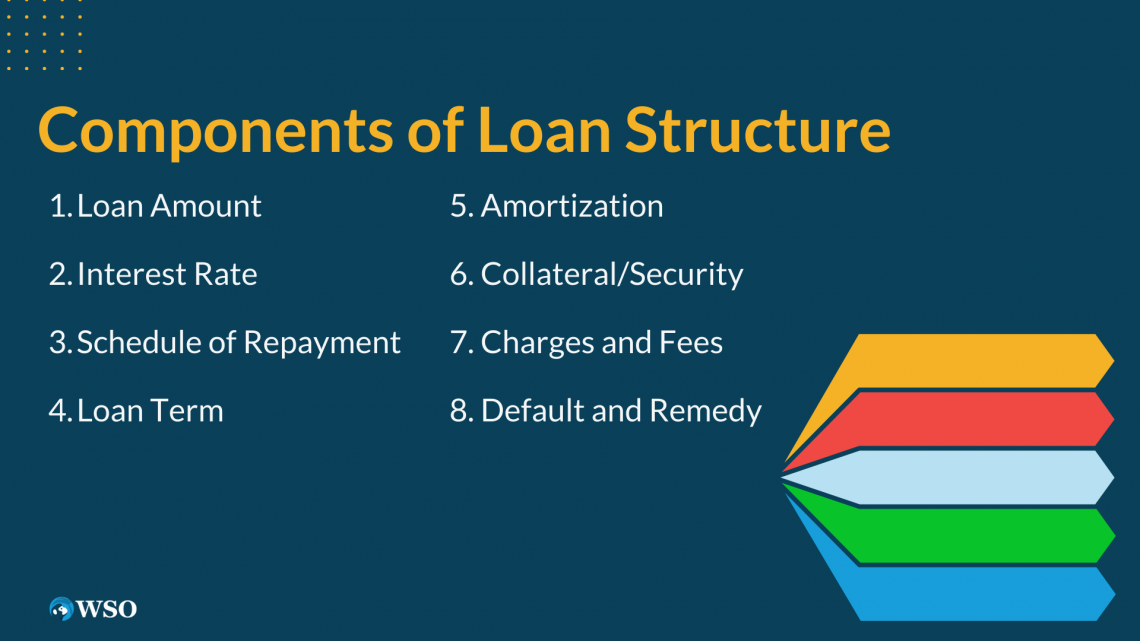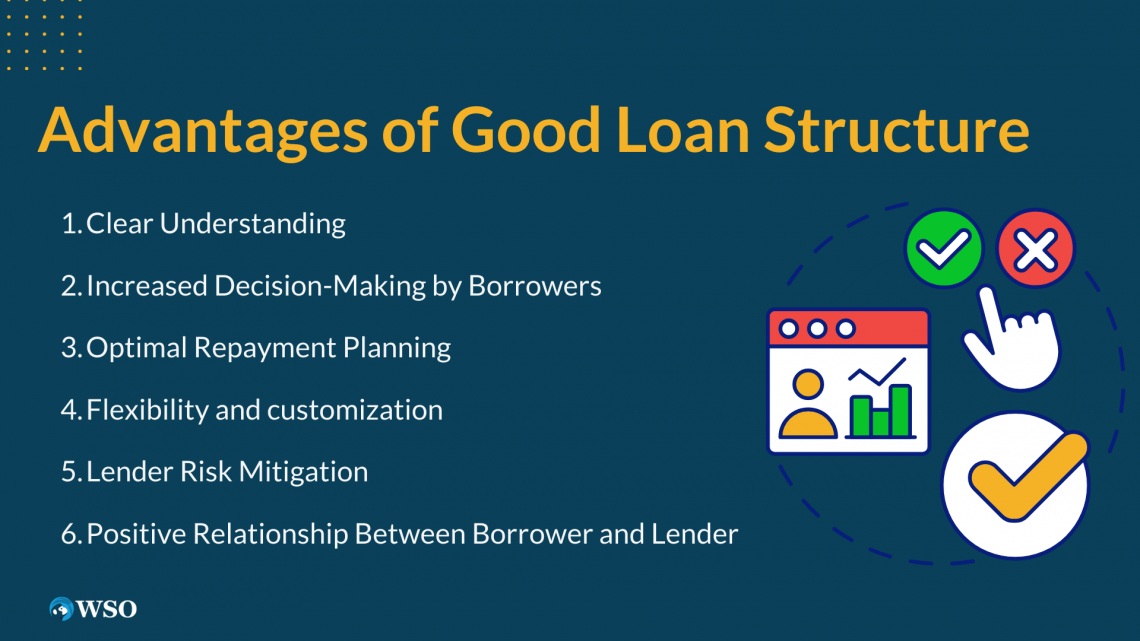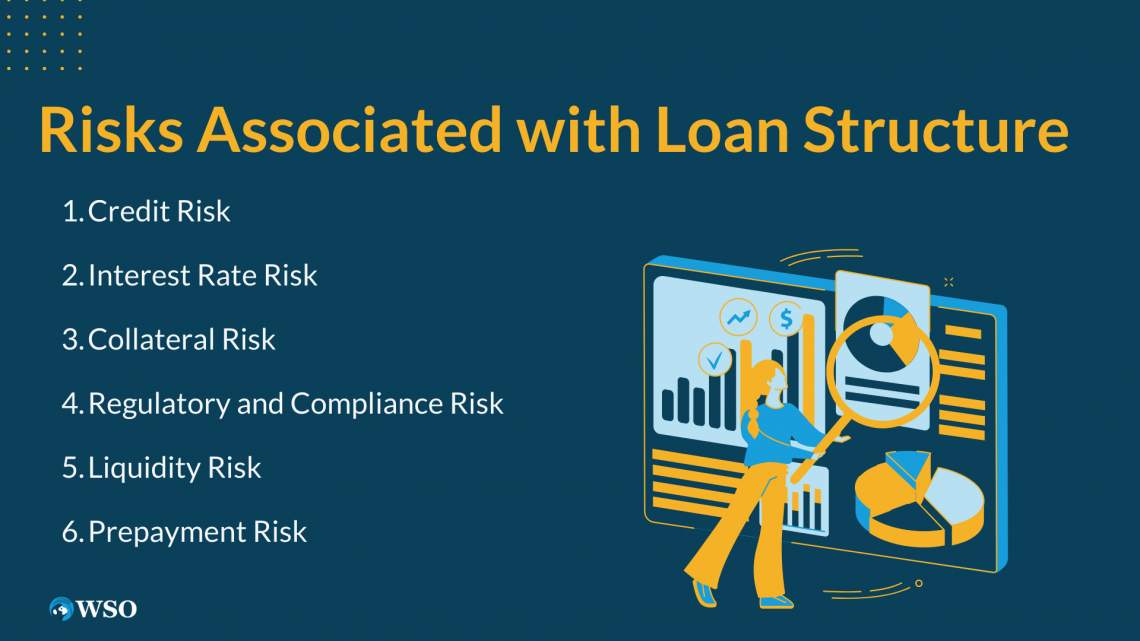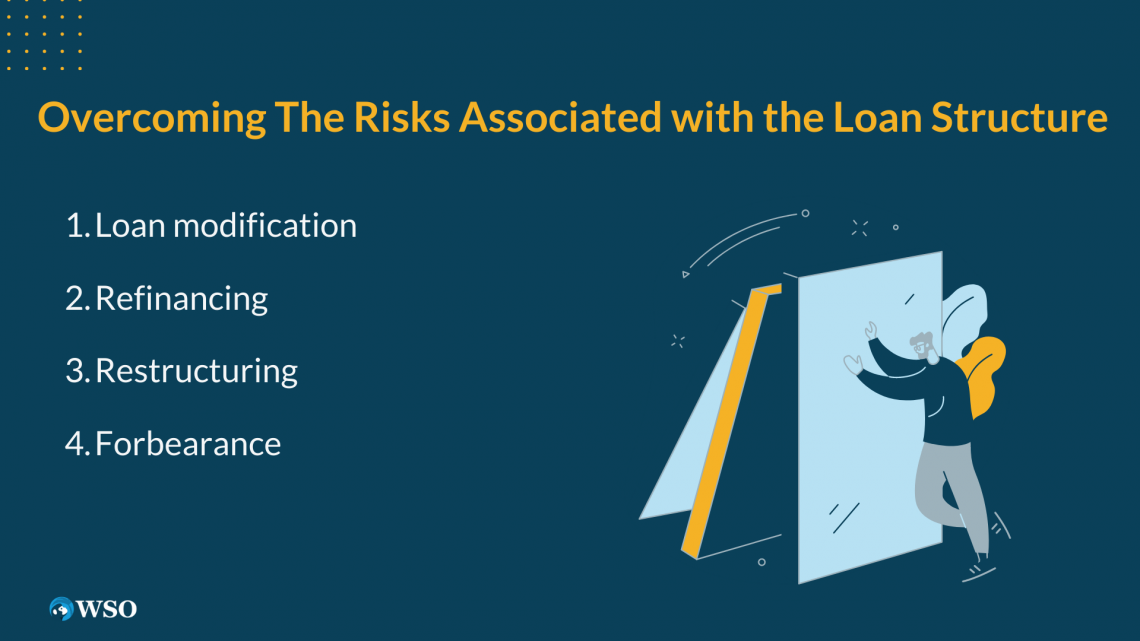Loan Structure
The loan structure outlines the conditions and factors governing the arrangement between a lender and a borrower
What is Loan Structure?
The loan structure outlines the conditions and factors governing the arrangement between a lender and a borrower. It is crucial to the lending process.

Both the lender and the borrower can ensure openness and make wise decisions if they are aware of the elements of a loan structure.
Understanding the structure is crucial for making educated decisions when borrowing money. The loan agreement's terms and conditions are defined by several components that make up the loan structure.
Various business needs necessitate borrowing funds from banks or other financial entities. For instance, they can want to buy new equipment, pursue development plans, acquire another business, or deal with unforeseen expenses.
They might also need more operating capital. The borrower repays the principal and interest over the length of the debt.
The word "loan structure" refers to a loan's objectives, amount, kind, interest rate, repayment options, and duration. A guarantor requirement or other covenants may be part of the structure's risk-mitigation strategies.
The goal of the debt, the borrower's risk tolerance, and the time range for repayment are some factors that affect the structure.
Key Takeaways
- The phrase "loan structure" describes a loan arrangement's particular terms and circumstances, such as the interest rate, repayment schedule, and other significant components that specify the borrower's duties and the lender's rights.
- The loan size should be carefully chosen to satisfy the borrower's needs while considering their ability to repay.
- The interest rate influences the cost of borrowing; thus, it should be assessed to secure the best terms.
- The length of the credit contract is determined by the credit term, which should align with the borrower's financial goals and capacity to repay.
- In some loan structures, collateral or security may be necessary to safeguard the lender in the event of a default.
Components of Loan Structure
Knowing the components of a loan structure, such as the principal sum, interest rate, repayment schedule, collateral requirements, fees, and default conditions, can help borrowers make intelligent decisions and effectively manage their borrowing.

1. Loan Amount
It is the sum that the borrower has borrowed as principal. It serves as the initial amount given by the lender and serves as the foundation for figuring out interest and payback responsibilities.
The suitable amount to satisfy the borrower's needs while considering their repayment capacity must be carefully determined.
2. Interest Rate
The interest rate, which determines the cost of borrowing, is an important part of any payment structure. The interest rate is the additional sum that must be repaid by the borrower in addition to the principal and is expressed as a percentage of the borrowing amount.
Note
To guarantee they obtain the most advantageous conditions, borrowers must examine the interest rates provided by several lenders.
3. Schedule of Repayment
The repayment schedule specifies the timing and frequency of credit repayments. It details how many payments will be, when they are due, and how much will be owed for each.
To ensure that the repayment schedule fits within their support means, borrowers should carefully analyze it. Monthly, quarterly, or annual installments are typical choices.
4. Loan Term
The loan term is the length of the credit contract. It specifies the time frame for the borrower's entire debt repayment. Long-term advances often last several years, whereas short-term debts normally last for a few months.
The length of the debt should be determined by the borrower's financial objectives and ability for repayment.
5. Amortization
Amortization is the process of steadily paying down the balance with consistent payments. Both principal and interest are included in each payment. The breakdown of each payment's principal repayment and interest component is detailed in an amortization schedule.
To monitor their payment progress and make informed financial plans, borrowers must thoroughly understand the amortization process.
6. Collateral/Security
In some circumstances, lenders could ask borrowers to offer security or collateral for the debt. In the event of a default by the borrower, collateral protects the lender. It might take the shape of valuable assets like real estate, cars, or other things.
Note
The agreement should outline the necessary collateral requirements and the consequences of default.
7. Charges and Fees
Any fees and charges that might be mentioned in credit agreements should be understood by borrowers. Examples of these are origination costs, processing fees, prepayment fines, and late payment fees.
For borrowers to accurately analyze the total cost of the credit and compare offers from other lenders, they must thoroughly understand the fee structure.
8. Default and Remedy
The agreement provisions specify when a borrower is deemed to be in default, such as when payments are late, or another agreement term is broken.
It also explains the steps the lender may take in the case of a default, including levying fines, filing lawsuits, or seizing assets.
Borrowers must have a comprehensive awareness of the consequences of default to avoid unfavorable outcomes.
Advantages of good Loan Structure
Both lenders and borrowers can benefit from a strong loan structure in several ways.

Here are a few major advantages of having a cleverly created payment structure:
1. Clear Understanding
A well-structured credit gives both parties involved clarity and transparency. It outlines all of the payment’s terms and conditions, including the amount of the debt, the interest rate, the payback terms, and any other fees or requirements.
This aids in both borrowers' understanding of their responsibilities and lenders' efficient lending process management.
2. Increased Decision-Making by Borrowers
Borrowers can make wise selections thanks to a solid credit structure. A detailed grasp of the debt terms will enable borrowers to analyze credit affordability, determine how it will affect their cash flow, and develop more effective financial strategies.
This lowers the chance of default and encourages more cautious borrowing.
3. Optimal Repayment Planning
A well-structured debt enables borrowers to schedule their repayments efficiently. Borrowers can plan their finances appropriately if they clearly understand the amortization timetable and the payback timeline.
Note
Reducing the possibility of missing payments or financial strain guarantees a simple repayment process.
4. Flexibility and customization
These are possible with a proper payment structure, depending on the needs and financial situation of the borrower. To accommodate diverse borrowers, lenders might provide a range of repayment terms, repayment alternatives, and interest rate structures.
This makes it easier for the borrower to identify a debt that meets their particular needs.
5. Lender Risk Mitigation
A well-structured debt aids lenders in reducing lending-related risks. Lenders can safeguard their interests and lessen the possibility of financial loss by implementing default provisions, defining the necessary collateral requirements, and establishing suitable interest rates.
6. Positive Relationship Between Borrower and Lender
A sound credit arrangement encourages a positive relationship between the borrower and the lender.
Building trust and goodwill requires open communication, transparency, and a fair debt arrangement. Long-lasting collaborations and possibly access to further funding may result from this.
Risks Associated with Loan Structure
Debts are a necessary source of funding for many different purposes, but it is important to understand the dangers of lending structures.

By being aware of these risks, borrowers and lenders may make wise decisions and implement effective risk management plans.
1. Credit Risk
Credit risk, or the potential for borrowers to miss debt repayments, is one of the major risks in credit systems. Lenders run the risk of not being paid or receiving payments late, both of which could lead to financial losses.
On the other hand, borrowers could have negative effects, including ruined credit histories and restricted access to future borrowing.
Interest rate risk results from the potential for interest rate changes during the debt’s tenure. Borrowers with variable interest rates incur the risk of paying more interest if interest rates rise, making it more difficult for them to make payments.
A lender may also be exposed to interest rate risk if they have fixed-rate obligations that could lose money if interest rates rise.
3. Collateral Risk
The value and marketability of the underlying assets are at stake when collateral is used in credit schemes. If the value of the collateral drastically decreases, lenders can have trouble getting their money back in the event of a default.
Similarly, borrowers risk losing priceless possessions if they fall behind on their payments and the lender seizes their collateral.
4. Regulatory and Compliance Risk
There are several regulatory restrictions and compliance obligations that apply to loan structures. The regulations governing lending practices, consumer protection, anti-money laundering, and data privacy must all be complied with by lenders.
Note
Legal repercussions, reputational harm, and financial penalties could arise from breaking these rules.
5. Liquidity Risk
Liquidity risk is the possibility of insufficient money to cover financial obligations. A borrower may have liquidity issues if their income or cash flow decreases, making it challenging for them to make timely debt repayments.
Lenders with a significant percentage of non-performing credits may experience liquidity risk, especially if they are smaller financial institutions.
6. Prepayment Risk
When borrowers pay off their debts before the agreed-upon maturity date, prepayment risk develops. Borrowers can benefit from early repayment, while lenders might lose out on anticipated future cash flows and see their interest revenue drop.
This risk is especially important for lenders offering fixed-rate credit with prepayment penalties.
How to overcome the risks associated with the loan structure
Although debt designs are intended to offer financial support, borrowers may nonetheless face challenges due to unforeseen events.

Knowing the many therapies that are accessible in such cases is crucial:
1. Loan modification
To solve persistent financial challenges, credit modification entails making permanent changes to the debt terms. This cure could be a decrease in interest rates, an extension of the debt’s duration, or a principal reduction.
Credit modifications are often negotiated between borrowers and lenders to provide more manageable repayment terms. It seeks to avoid default and allow borrowers to fulfill their debt commitments over an extended period.
2. Refinancing
Refinancing enables borrowers to swap out their current debts for new ones with better conditions or interest rates. When their creditworthiness improves, or they can find a lower interest rate on the market, borrowers can look into refinancing options.
Refinancing might help you shorten the credit term, lower your monthly payments, or combine many credits into one.
3. Restructuring
Restructuring debt is an option for borrowers with financial difficulties. To make debt repayment more reasonable, it entails changing the conditions of the loan arrangement.
Options for restructuring can include extending the credit’s term, lowering the interest rate, or changing the repayment plan. Borrowers can achieve financial stability and increase their capacity to repay debt by working with lenders to restructure the debt.
4. Forbearance
Forbearance is a temporary relief that enables borrowers to postpone or scale back their credit payments for a set time. This cure is frequently provided in situations involving sudden financial difficulties, such as job loss or unforeseen medical expenses.
Although interest may continue to accrue during forbearance, it reprises debtors from making regular credit payments.
Loan Structure FAQs

The loan structure is crucial because it impacts the borrower's capacity to repay the credit, the cost of borrowing, and both parties' total financial standing.
The credit must be appropriate for the borrower's needs, the lender's risks must be kept to a minimum, and effective credit repayment is encouraged by a well-designed loan structure.
The interest rate influences the total sum that the borrower will have to pay back during the loan term and determines the cost of borrowing. The total cost of the debt rises with higher interest rates while falling with lower rates.
The interest rate also impacts the monthly payment amount and the borrower's affordability.
Borrowers should consider their long-term financial goals, repayability, and financial necessities while deciding on the loan amount. It's crucial to borrow a sum that's affordable and compatible with the borrower's capacity to make consistent payments without experiencing undue financial hardship.




or Want to Sign up with your social account?